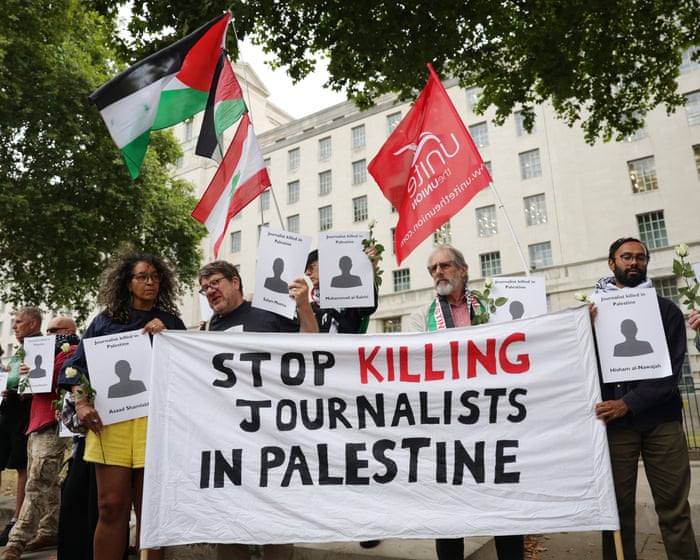Day by day, the death toll climbs, war crimes accumulate, and outrage intensifies. Last Wednesday, the Pope called on Israel to end what he described as the “collective punishment” of Gaza’s population. The following day, UN Secretary-General António Guterres warned that the scale of death and destruction is “unmatched in recent times.” More than 500 UN staff have urged the human rights chief, Volker Türk, to label the situation as genocide. In the US, half of registered voters already believe that is what Israel is doing in Gaza.
The suffering is worsening. On Friday, the Israeli military declared famine-stricken Gaza City a combat zone, escalating its assault and halting the limited—and entirely insufficient—humanitarian pauses that had allowed some food deliveries. Many residents are too weak to flee again and fear they would be no safer elsewhere. Israel has even attacked areas it had previously designated as “humanitarian zones.”
Israel could halt international condemnation by ending its campaign of destruction. Instead, it seeks to control the narrative, silencing those who bear witness. This has become the deadliest conflict for journalists in modern history. According to the Committee to Protect Journalists (CPJ), at least 189 Palestinian journalists have been killed in Gaza; other estimates are even higher. Five were killed in a single strike last week.
Reporters Without Borders (RSF) and the advocacy group Avaaz are urging Israel to uphold its duty to protect journalists as civilians and to open Gaza’s borders to allow international reporters to work freely.
The Guardian is publishing the names of those journalists confirmed killed by CPJ—people like Fatma Hassona, Hamza al-Dahdouh, and Anas al-Sharif, respected for their work and deeply missed as family and friends. These losses are personal, but they also represent the erasure of an entire generation of journalists that cannot be replaced.
As Thibaut Bruttin, RSF’s director general, warned: “At the rate journalists are being killed in Gaza by the Israeli army, there will soon be no one left to keep you informed.”
The CPJ has stated that this is “the deadliest and most deliberate effort to kill and silence journalists” it has ever documented. Palestinian journalists, it says, are “threatened, directly targeted, and murdered by Israeli forces, and arbitrarily detained and tortured in retaliation for their work.”
Journalists in Gaza operate under unbearable conditions—hungry, exhausted, and often interrupting their reporting to search for food, help recover bodies, or assist injured relatives. Many are separated from loved ones; many have buried family members. All know that by bearing witness, they increase the risks they face. They continue their work to defend the truth against Israel’s efforts to suppress it. They, in turn, must be protected.
Do you have an opinion on the issues raised in this article? If you would like to submit a response of up to 300 words by email for possible publication in our letters section, please click here.
Frequently Asked Questions
Of course Here is a list of FAQs about the topic designed to be clear and helpful
BeginnerLevel Questions
1 What is this article about
This article from The Guardians editorial board argues that Israels military has been deliberately targeting journalists in Gaza to prevent the world from seeing the full impact of its actions there
2 Why would a country target journalists
The article suggests its an attempt to control the narrative By limiting journalists ability to report it becomes harder for the outside world to witness and verify events on the ground potentially hiding evidence of human suffering or military tactics
3 Is it illegal to target journalists
Yes intentionally targeting journalists who are clearly identified as noncombatants is considered a war crime under international humanitarian law specifically the Geneva Conventions
4 How many journalists have been killed
The number is constantly changing due to the ongoing conflict The article references a high number of journalist casualties For the most current figure you should check recent reports from organizations like the Committee to Protect Journalists or Reporters Without Borders
IntermediateLevel Questions
5 What evidence does The Guardian provide for this claim
The editorial points to the unusually high number of journalist deaths the pattern of strikes on their family homes and the fact that many were wearing press insignia suggesting they were clearly identifiable as noncombatants
6 What is The Guardians view Is this a news report or an opinion
This is an editorial which represents the official opinion of The Guardians editorial board It is based on facts and events but is explicitly an argument or a take on those events not a straight news report
7 Has Israel responded to these allegations
Yes the Israeli military typically states that it does not target journalists and that its operations are aimed at militant groups like Hamas They often claim that journalists were caught in crossfire or were in close proximity to legitimate military targets
8 What is the difference between a targeted strike and being caught in crossfire
A targeted strike implies a deliberate decision to attack a specific person or location Caught in crossfire suggests an accidental death occurring during a firefight between two opposing forces The controversy lies in determining which scenario is accurate in each case
AdvancedLevel Questions




